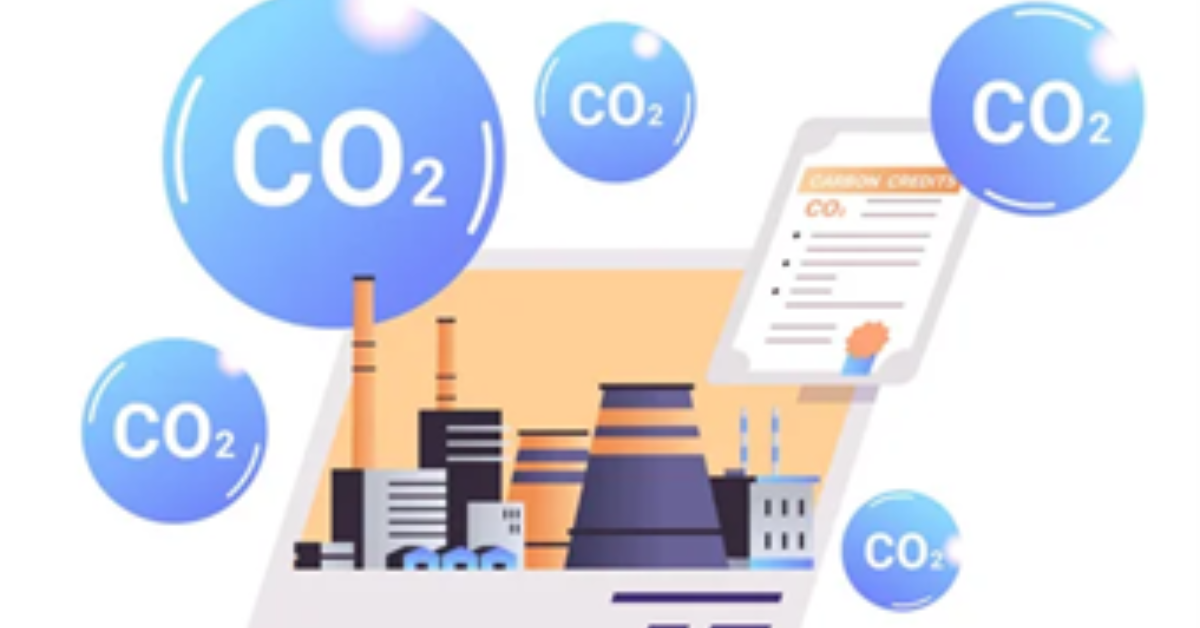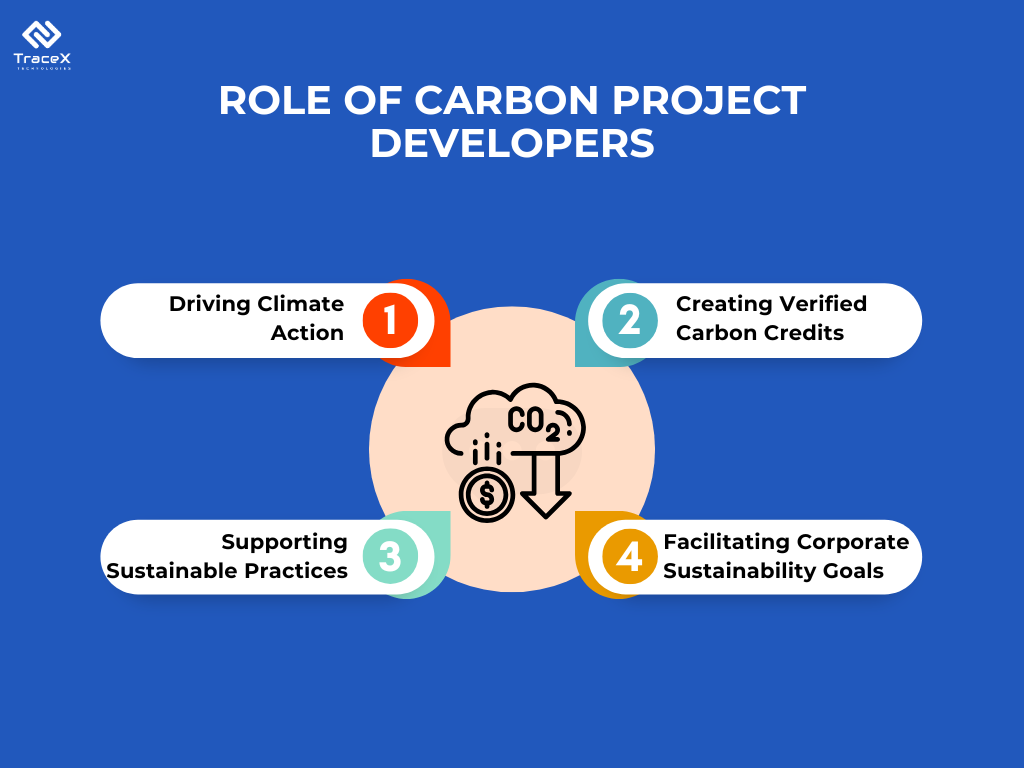Contact: +91 99725 24322 |
Menu
Menu
Quick summary: Explore the crucial role played by project developers in the carbon market. Learn how they drive climate action, navigate challenges, and bring carbon projects to life.

In the fight against climate change, carbon project developers play a key role in turning ambitious climate goals into tangible outcomes. But why are they so vital to the Voluntary Carbon Market (VCM)? The problem is that, for many businesses, navigating carbon credits can be complex and challenging. Without the expertise and guidance of carbon project developers, it’s difficult to ensure that emission reduction projects are both impactful and compliant. As demand for credible carbon credits rises, the role of these developers becomes more important than ever.
The Taskforce for Scaling the Voluntary Carbon Market, which was established by the private sector to help the market meet the goals of the Paris Agreement, states that the voluntary carbon market must scale at least 15-fold by 2030 in order to play its part in the delivery of global climate targets.
Whether it’s renewable energy installations, afforestation projects, or sustainable agriculture ventures, project developers are the architects of innovative solutions that not only mitigate carbon emissions but also create positive environmental and socio-economic impacts.
Key Takeaways
Carbon project developers are individuals or organizations that develop and manage carbon offset projects. These projects are designed to reduce or remove greenhouse gas emissions from the atmosphere. Carbon offset credits are generated when a carbon project reduces or removes emissions beyond what would have happened anyway, and these credits can then be sold to businesses and individuals to offset their own emissions.
Carbon project developers play an important role in the fight against climate change. They work to identify, develop, and implement projects that have a real and measurable impact on greenhouse gas emissions. Carbon project developers also work to ensure that their projects are sustainable and deliver other benefits, such as job creation, improved air quality, and biodiversity protection.
These developers aren’t limited to just one type of project or place. They work in all sorts of areas and industries, wherever emissions need to be reduced. This could mean building huge wind farms in open spaces, bringing forests back to life in tropical regions, or creating new, eco-friendly ways for industries in cities to work. They’re like change-makers in action, where it matters most.
Some of the most common types of carbon offset projects include:
Carbon project developers typically work with a variety of stakeholders, including project owners, government agencies, communities, and carbon credit buyers. They also need to have a deep understanding of the carbon market and the various carbon standards that exist.
Carbon project developers and the voluntary carbon markets share a symbiotic relationship, each essential to the success of the other. These markets serve as platforms where the results of developers’ hard work and commitment to emission reduction are transformed into valuable assets known as carbon credits.
Carbon project developers bring fresh ideas and initiatives to the table, creating innovative projects that reduce greenhouse gas emissions. These projects, whether they involve renewable energy installations, reforestation efforts, or emissions-reducing technologies, are designed to contribute to a more sustainable and environmentally friendly future.
Carbon credits are the tangible outcome of these projects. Each credit represents a quantifiable reduction in greenhouse gas emissions. The process of generating carbon credits involves meticulous planning, implementation, and verification to ensure that the emissions reductions are real, measurable, and adhere to recognized standards.
For example, in a renewable energy project, the reduction in carbon emissions is measured by comparing the emissions generated by the renewable energy source to the emissions that would have occurred if a non-renewable energy source had been used. This reduction is then translated into carbon credits, with each credit typically representing one metric ton of carbon dioxide equivalent (CO2e) emissions avoided.
Carbon project developers and voluntary carbon markets are intricately linked in the pursuit of climate action. Developers bring ingenuity and dedication to creating emission reduction projects, while carbon markets provide the means to turn these efforts into tangible carbon credits. A thriving carbon credit market is pivotal in incentivizing emission reductions, driving innovation, and fostering international cooperation in the fight against climate change.

Corporate climate leadership is evolving, prompting companies to seek expert guidance in crafting strong commitments and sustainable action plans. Trusted partners are instrumental in developing long-term strategies. Many corporations are now interested in a diverse portfolio of projects that yield reliable emissions reductions, ensuring that their climate claims align with best practices and maintain credibility. Reputation management during the decarbonization process is also gaining significance, as media scrutiny intensifies, making transparency and accuracy essential to avoid any potential misperceptions. They depend on project developers to offer impartial assurance regarding a project’s quality, integrity, and impact. This is diligently carried out with rigorous quality assurance on their behalf, instilling in them the certainty needed to make investments.
Every company has its unique preferences when it comes to the kinds of projects and their preferred locations for climate action. Many companies choose to support a diverse portfolio of projects that align with their specific needs. Adopting a portfolio strategy allows these businesses to mitigate risk, stay within budget constraints, and contribute to various regions that are relevant to their operations.
For individual project developers, tapping into this diverse demand can be challenging. Collaborating with a partner who has cultivated and comprehends these client relationships and has established the necessary systems and processes to meet and exceed client expectations, becomes a more attractive option.
In addition to verified emissions reductions, corporations are increasingly motivated by the additional positive impacts of projects, particularly those aligned with the UN Sustainable Development Goals (SDGs). Highlighting the favorable social, biodiversity, and equity effects delivered by our project partners plays a crucial role in enticing companies to acquire carbon credits or support project development.
These developers opt to collaborate with project implementation partners who possess an in-depth understanding of local stakeholders and ecosystems, along with the highest ethical standards. Furthermore, these developers assist in quantifying these diverse benefits for corporations by guiding projects through various certifications.
Nature-based projects for carbon credits are gaining significant traction as a solution for tackling climate change. These projects focus on conserving, restoring, or managing natural ecosystems like forests, wetlands, and grasslands to absorb and store carbon dioxide from the atmosphere. By protecting these ecosystems or enhancing their carbon-storing capabilities, such projects generate carbon credits that can be traded in the Voluntary Carbon Market (VCM). For example, reforestation projects can sequester CO2 while also providing biodiversity benefits and supporting local communities. As companies and governments seek credible ways to meet their carbon reduction targets, nature-based solutions offer a dual benefit—climate mitigation and ecological preservation.
Numerous established methodologies exist for generating carbon credits across various project types, including agroforestry, afforestation, reforestation, cookstoves, clean water access, bioenergy, and sustainable land management.
Carbon project developers play a crucial role in mitigating climate change, but they encounter several significant challenges in their work.
These challenges highlight the intricate nature of carbon project development, which involves financial acumen, regulatory expertise, and a commitment to demonstrating real and measurable emissions reductions. Successfully addressing these challenges is essential for advancing climate action and achieving the goals of emission reduction projects.
Digital MRV solutions are here to make life easier for project developers who work on carbon credits. Traditionally, tracking carbon reduction has been a hassle—manual data collection, lengthy verification processes, and inconsistent results make it tough to get things done smoothly. That’s where digital MRV steps in.
With tools like IoT sensors and AI, these solutions automatically gather data in real-time, cutting down on manual work and minimizing errors. This means project developers can focus more on their projects and less on paperwork. Plus, with blockchain technology, every bit of data is securely stored and transparent, making it easy to prove the impact of their efforts. The result? Faster verification, better accuracy, and reduced costs, all while meeting the strict standards of carbon markets.
VNV utilized TraceX’s Digital MRV Platform to effectively monitor sustainable practices within their operations. By leveraging this technology, they ensured accurate data collection, which facilitated the implementation of activities aimed at reducing carbon emissions. This partnership underscores the importance of reliable data in promoting sustainability and achieving carbon reduction goals.
The TraceX Digital MRV (DMRV) platform is designed to simplify and enhance the process of carbon credit verification for project developers. It uses advanced technologies like IoT, satellite imagery, and blockchain to ensure accurate, real-time data collection and reporting. With TraceX’s platform, project developers can monitor their carbon reduction efforts directly from the field, leveraging IoT sensors for precise data on factors like soil health, crop growth, and carbon sequestration.
The blockchain backbone ensures that all collected data is secure, tamper-proof, and traceable, providing a transparent trail for verification bodies. This transparency helps streamline the validation process, saving time and reducing the costs associated with third-party audits. In short, TraceX’s DMRV platform helps project developers by automating data collection, ensuring transparency, and making it easier to prove the impact of their sustainability projects, making the process smoother, faster, and more reliable.
Carbon Project developers have a significant opportunity to capitalize on the growing corporate demand for climate change mitigation projects, whether they focus on emissions removal or avoidance. However, navigating this demand and securing upfront development funding can be a complex process. For project developers seeking to expand their influence in the climate action arena, partnering with an experienced collaborator is essential. Looking for a partner with access to financing, a strong reputation among major creditworthy credit buyers, a robust technology solution provider, a deep understanding of the intricacies of carbon finance project development, and the ability to stay informed about market dynamics could impact their projects.
Project developers are key players in identifying, designing, and implementing carbon reduction and removal projects. They take these projects from concept to reality, ensuring they meet stringent quality and integrity standards.
Project developers encounter challenges related to project viability, complex carbon accounting, and access to carbon offset markets. They must navigate these hurdles to bring impactful carbon reduction projects to fruition.
Tracex DMRV offers project developers robust carbon accounting and verification solutions. It helps streamline the MRV (Measurement, Reporting, and Verification) process, ensuring compliance with carbon market standards and increasing transparency and trust in carbon projects.
